YuYu interview Alexander Chuang Ph.D.
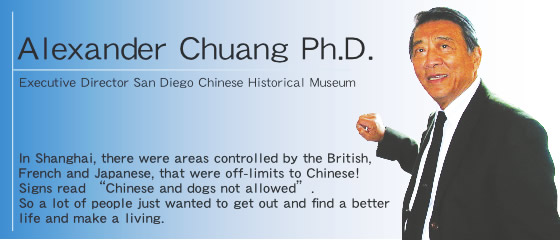 |
| —— Could you tell me how the San Diego Chinese Historical Museum got its start? Well around 1985, a group of Chinese Americans, Tom Hom and Buddy Wong, among others, founded the Chinese Historical Society of Greater San Diego and Baja California with the goal of protecting, collecting and preserving the history of this area. When I joined the board in 1987 we began the process of establishing a museum where people could come and experience these things first hand. 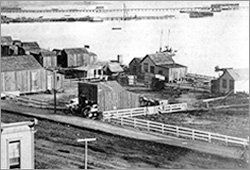
Santa Fe Wharf from Market and Kettner Blvd. in 1890, now home to the San Diego Convention Center and Sheraton hotels.
Tom Hom was a former council member, so he knew how things in the city worked, and he started working on having the city help us in getting some land for the museum. In 1991, after years of trying, the city provided us with this property at 404 Third Ave. here in the original Chinatown district. At that time it was a slum, but we were very happy to have it. The building is the original Chinese Mission, which was donated to us by Charles Tyson. It used to be over on First Ave. where the Ralphs supermarket is now and had been abandoned since the 60s. We actually got the building first, but had no place to put it! Back then there wasnユt anything here. No convention center, no hotels nothing. When we finally got the and we had another problem, the land already had a building on it so we had to move it before we could bring the mission building here. We had organized a museum construction committee; I was the Chair, along with Tom Hom, Dorothy and Joseph Wong, Dr. Lily Chen and a good friend Ambassador Drumright. About 2 years later, in 1993, we had an official groundbreaking ceremony, but we still didn't have enough money for the relocation, renovation and reconstruction. Eventually we raised the money. $460,000, through local contributions and with help from Taiwan. In 1995, we finally started the reconstruction and in 1996 we dedicated the building ノbut we still didn't have anything to put in it! It was completely empty. —— So finally you had the building, the land, raised money for the construction and started building, but had nothing to display? No! Nothing, except for a simple panel display called "In Search of Gold Mountain", which we still have. So at the grand opening we put it in the center of the museum, we didn't even have any chairs! At that time, along with myself there was only one lady who worked with me and so little by little, piece-by-piece, we began building our collection of artifacts and memorabilia. On occasion we may purchase something, but very rarely. Most things have been donated to us, so that we can preserve them and share them with everyone. For example the Birch Aquarium had donated several pieces and so have many families from their collections. 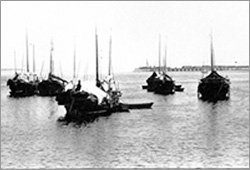
Chinese fisherman prospered for a time. Some of the 18 “junks” that called San Diego Harbor home in 1887.
Anything that documents or gives people some insight into what life must have been like here for people back then. We're very proud to have recovered many things from the excavation that took place where the Chinese fishing village used to be. Thankfully we saved so many small things before they were lost to us forever due to redevelopment. That was an area was were the Chinese community lived and prospered, but back then it wasn't worth anything at all. Now it's some of the most valuable real estate in all of San Diego. Penthouses are worth five million dollars where before there were only broken down shacks. Those things, as simple as they are, are some of our most treasured pieces because they are so hard to come by. Some would say they're worthless, but to us their historical significance and the era they represent make them priceless. Have you seen our Chinese lottery machine? That style machine started here 70 or 80 years ago and is still used for "keno" in Las Vegas. Selling lottery tickets wasn't illegal back then and the prize if you won was worth around 2,000 dollars! —— This is great building. What was the Chinese Mission before it became home to your museum? The Chinese Mission began in 1885 and was a center, where Chinese immigrants could find employment and prepared people for their new environment and helped them adapt to their new life in America. Besides religious instruction and worship, the Mission also served as a place to live for some and as a social center for the community. Over the years so much history has passed through these doors, so I think it's appropriate that it continues to serve the community in this way. —— Looking at it now, it’s hard to imagine this whole area back then. Would you tell us a little about San Diego’s Chinatown? Of course! It was right in the middle of what everyone now calls the "Gaslamp" district, south of Market, between Second and Fifth Avenues extending all the way down to the fishing village (the Convention Center), where the Chinese fishermen lived in their little wooden shacks. That's where the excavation took place. It was much smaller than LA's or San Francisco's. In 1880, the Chinese population was only 229 compared with a total population of 8,618 for all of San Diego. San Diego was very segregated in those days. There was a Chinatown, a Little Tokyo, an area where mostly blacks lived and a red-light district. Even though they were close in proximity the communities never really mixed too much. Language was a problem culture too. Chinese didn't speak English or at least not very well, so that's why they formed these little Chinatowns. In these areas newcomers didn't need to speak English and business was frequently conducted in and among themselves. —— What originally brought the first Chinese immigrants to the U.S.? Poverty and their desire to build a better life, like so many of the people who came here. At one time during the Ching Dynasty, China was one of the most powerful countries in the world. Their territory was vast, from Korea to Central Asia, and from Siberia to Vietnam, but over time China went into a steep decline. In fact in Shanghai, there were areas controlled by the British, French and Japanese, that were off-limits to Chinese! Signs read "Chinese and dogs not allowed". So a lot of people just wanted to get out and find a better life and make a living. The voyage here was difficult and expensive. People would come by ship and it took a long time, conditions were very difficult and many people died just trying. They often came selling themselves to the labor contractors hard, dirty labor and of course you had to pay them back. After 10 years, if you survived, you were free to do what you could. It was just like slavery. —— When did Chinese settlers first start coming to San Diego? The first Chinese came to San Diego around 1860 and they were mostly fishermen. One group was located in Point Loma and there was another fishing village down the street from here where the Convention Center is today. In their heyday, until the 1890's, Chinese fisherman built and sailed 18 traditional Chinese fishing "junks". The boats were made mostly from California redwood and the fishermen were very successful maybe too successful. You see, the local fisherman and people started becoming jealous and wanted something done about it. Soon discriminatory laws like the "three-mile" law were enacted which basically said that any person sailing beyond three miles offshore had left US territory, and so foreigners doing so were re-entering the country and were doing so illegally! As you can imagine this severely limited what fishing could be done and effectively killed the Chinese fishing industry. —— What did everyone do after that? The Chinese immigrants were actually sought after as laborers, because they did good work and were cheap. In the late 1800ユs Chinese labor was instrumental in projects like the railroads and the San Diego Flume, which at one time carried water from the Cuyamaca reservoir to San Diego over 36 miles! They also helped to build the Hotel Del Coronado and were very involved in mining for gold and other precious gems in the Julian area, especially "pink" tourmaline which was highly valued in China. At that time there was a man named Ah Quin, who had come to San Diego when the railroads were being built. Since he could speak English well, he served as a type of liaison between the Chinese and American communities. Ah Quin helped to bring Chinese laborers from San Francisco south to work on the California Southern Railroad, which stretched from National City up to San Bernardino. Within the community he was well loved and respected and became known as the "mayor" of Chinatown. Interestingly, he kept a detailed diary in English, over 1,500 pages long, that is perhaps the best-known first-hand account of local Chinese life and affairs of the time. —— What events led to your personal journey to the US? 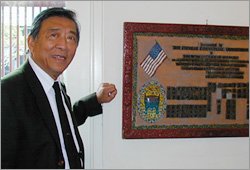 I was born in China in 1934. You have to understand that this was the time of the Japanese aggression, when they invaded Korea, took Taiwan and eventually all of China. We were living in Nanking and I was just three years old when the Japanese took control. It was terrible and so my mother took me and my sister, and we escaped, just before the terror of the infamous "Rape of Nanking". We were fortunate we survived. I still have one very vivid memory when I was at the railroad station, both my sister and I had malaria and there were constant air raids by the Japanese bombers, so the whole railroad station was empty. We were sitting at the station with our luggage and two sick kids, but we stayed, because we didn't have anywhere else to go! My father was gone with the government and my younger brother was too young to come with us, so my mother arranged for someone to hide him in the countryside. I was born in China in 1934. You have to understand that this was the time of the Japanese aggression, when they invaded Korea, took Taiwan and eventually all of China. We were living in Nanking and I was just three years old when the Japanese took control. It was terrible and so my mother took me and my sister, and we escaped, just before the terror of the infamous "Rape of Nanking". We were fortunate we survived. I still have one very vivid memory when I was at the railroad station, both my sister and I had malaria and there were constant air raids by the Japanese bombers, so the whole railroad station was empty. We were sitting at the station with our luggage and two sick kids, but we stayed, because we didn't have anywhere else to go! My father was gone with the government and my younger brother was too young to come with us, so my mother arranged for someone to hide him in the countryside. Our family was broken into three. We went from city to city looking for my father, but each time he was gone again. Once, in Guangzhou while the city was evacuating, we tried boarding a train, but it was already packed so tight. People were frantic so my mother handed me through an open window to someone and then fought her way onto the train. Life stayed like that until the Allied victory in 1945, then we made our way back to Nanking. Nine years later and we finally went back home our house was burned and everything we had was gone, but miraculously we were reunited with my younger brother! Somehow he had survived! Not long after Japan's defeat came China's revolution and we had to leave again this time for Taiwan. In Taiwan I started my formal schooling and later attended Taiwan's top school, National Taiwan University. After graduating and serving my two years in the army, I became a teaching assistant at the University, and started the process of going abroad. I passed an exam to study abroad and dealt with the Embassy. I took so many exams back then! Finally in 1962, I arrived in the U.S. and entered the University of Massachusetts. I'm a Chinese-American and I truly appreciate all the opportunities I've had in the US. I think it's the best place that's my fair opinion, but I'm still interested in trying to find out and preserving my roots. 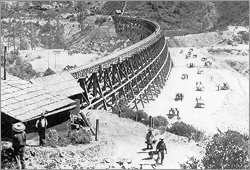
Chinese laborers were critical to San Diego construction. Here shown working on the Central Pacific Railroad in the foothills of the Sierra Nevada.
Since we've opened the museum we've presented more than 39 exhibits highlighting the traditions of Chinese culture, here and throughout the world. We're always working on a new exhibit, adding to our library, or reaching out to the community through our education programs, but lately we've been very focused on completing the museum's extension. We still have much to do, but it's getting closer. The front window is going to have a three-part picture window. One of the windows will feature a traditional Chinese pharmacy, another will be a traditional study, and the third will be a rotating display presenting various early Chinese-American living quarters. We're excited, but some of these pieces are hard to come by, because when the Chinese first came here they were so poor so as soon as they got a little bit of money they threw them all away. Not too many things were saved and now that downtown is being redeveloped many of the things will be lost forever. The city has designated this area the "Asian Pacific Thematic District", and it has been trying to encourage business owners to come back, but so many people have told me, Alex, do you know how expensive this area is now? We can't afford to run our business there. We were fortunate to have purchased the space when we did, because we couldn't have afforded it at today's prices. —— How do you feel when you look back at all you’ve accomplished after all the hard work you and your supporters have put in? I feel very, very proud, because we've been able to save part of San Diegoユs and our Chinese history here and share it with the world. Our slogan reads, "There are 5,000 miles of mountains and rivers, you'll never see them all, and there are 5,000 years of culture, you'll never enjoy them all." There's so much to learn. (04-16-2004 issue, Interviewed by Terry Nicholas) |

